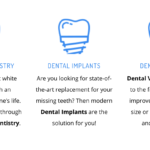Are you tired of feeling self-conscious about your smile? Do damaged or missing teeth prevent you from living life to the fullest? Restorative dentistry may be the solution you’ve been looking for. This innovative branch of dentistry focuses on repairing and replacing teeth, allowing patients to achieve a healthy, functional, and beautiful smile. In this blog post, we’ll delve into the different types of restorative dentistry procedures available, along with the numerous benefits they offer. Whether you’re seeking to enhance your appearance or improve your oral health, read on to discover how restorative dentistry can transform your life.
What is Restorative Dentistry?
Restorative dentistry is a specialized branch of dentistry that focuses on repairing and restoring damaged teeth. It involves a range of procedures designed to improve the function and appearance of your teeth, such as filling cavities, placing dental crowns or bridges, and even replacing missing teeth with dental implants.
One of the key goals of restorative dentistry is to preserve as much natural tooth structure as possible while also addressing any damage or decay. This helps to maintain good oral health in the long run.
Depending on your specific needs, your dentist may recommend one or more restorative procedures to address issues like tooth decay, gum disease, cracked or broken teeth, or missing teeth. Some common types of restorative dental treatments include fillings, root canals, extractions, dental crowns and bridges.
Restorative dentistry offers many benefits for patients who are looking to enhance their smile and maintain optimal oral health. By working with an experienced dentist trained in this field,you can achieve a healthy mouth full of beautiful pearly whites!
The Different Types of Restorative Dentistry Procedures
Restorative dentistry offers a range of procedures to help restore the appearance and function of teeth that have been damaged or lost. Here are common types of restorative dentistry:
1. Fillings – used to repair cavities caused by decay, fillings are typically made from materials like composite resin or amalgam.
2. Crowns – also known as caps, crowns cover a tooth that has been weakened by decay or damage. They can be made from porcelain, metal, or a combination of both.
3. Bridges – used to replace one or more missing teeth, bridges consist of artificial teeth attached to adjacent natural teeth for support.
4. Implants – one of the most popular restorative dental options today, implants involve placing an artificial root into the jawbone to support a replacement tooth.
5. Dentures – ideal for those who have lost multiple teeth due to injury or disease, dentures come in full and partial varieties and can be removed for cleaning.
Each type of procedure has its own unique benefits and considerations depending on your specific needs and preferences. It’s important to speak with your dentist about which option is right for you so you can achieve optimal oral health and function once again!
The Benefits of Restorative Dentistry
Restorative dentistry is an excellent solution for patients who have missing, damaged or decayed teeth. This type of dental care focuses on restoring the function and appearance of your teeth so that you can confidently smile, chew and speak without any discomfort or embarrassment.
One of the primary benefits of restorative dentistry is improved oral health. Restoring damaged or decaying teeth not only improves their aesthetic appeal but also helps prevent further damage to adjacent teeth. Filling in gaps caused by missing teeth also reduces the risk of gum disease and tooth decay by eliminating potential bacterial breeding grounds.
Another benefit is increased confidence. When you have a healthy set of functional and attractive-looking teeth, you’ll naturally feel more confident about your smile, which positively impacts other areas of your life as well.
Moreover, restorative dentistry procedures are typically minimally invasive with little downtime required for recovery. Whether it’s getting a filling or undergoing implant surgery – many procedures can be completed in one appointment meaning less time off work!
Restorative dentistry also offers long-lasting results – properly cared for implants can last decades while fillings may need replacing after several years depending on care received.
Investing in restorative dental treatments has numerous benefits from improving oral health to boosting self-confidence- all while increasing revenue for your practice!
How to Find a Restorative Dentist
Finding a restorative dentist can be overwhelming, as there are many options to choose from. However, by following a few simple steps, you can make the process easier and find the right dentist for your needs.
Firstly, ask for recommendations from family and friends who have undergone restorative dental procedures. They may be able to provide valuable insight into their experience with a specific dentist or practice.
Secondly, conduct online research on local restorative dentists in your area. Look at their websites and read reviews from previous patients to gauge their reputation.
Thirdly, schedule consultations with potential dentists to discuss your needs and assess whether they are a good fit for you. This will allow you to get a feel for their communication style and expertise in restorative dentistry.
Consider the cost of the procedures and whether it is within your budget. Many insurance plans cover some or all of the cost of certain restorative dental procedures.
By taking these steps, you can find a qualified and trustworthy restorative dentist that meets both your oral health needs and financial constraints.
Conclusion
Restorative dentistry procedures provide a variety of benefits for patients looking to improve the health and appearance of their teeth. From repairing damaged or missing teeth to improving oral function and preventing further dental issues, restorative dentistry can be an excellent investment in your long-term dental health.
If you’re considering restorative dentistry, it’s important to find a qualified dentist who has experience performing the specific procedures you need. Look for a dentist who is skilled in using the latest techniques and technologies and who has a strong reputation among patients.
Restorative dentistry can also be an effective way for dental practices to increase revenue by offering high-value services that are in demand from patients. By increasing your dental practice revenue you should invest in training and equipment for these procedures, practices can attract more patients seeking comprehensive care and build stronger relationships with existing ones.
Whether you’re a patient seeking to restore your smile or a practice looking to expand its service offerings, there are many compelling reasons to explore the world of restorative dentistry. By taking advantage of these powerful techniques, you can enjoy improved oral health, greater confidence, and increased satisfaction with your overall dental care experience.








